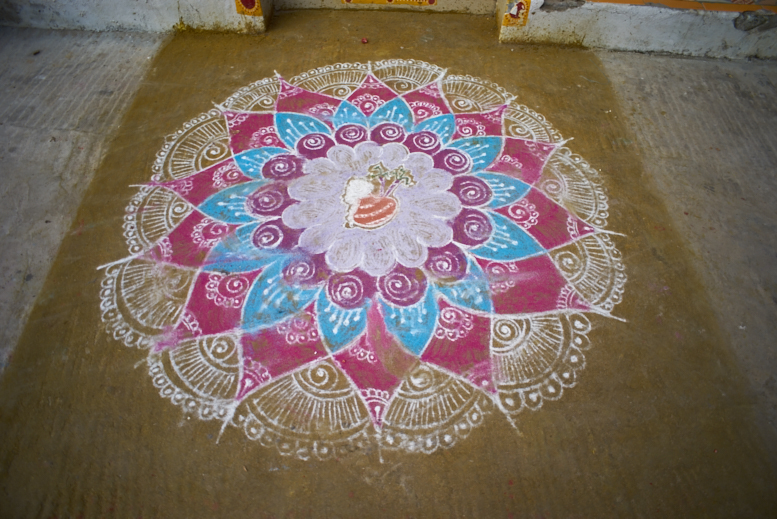
That which feeds the eyes, feeds the soul.
Kolam, alpana or rangoli is a humble yet very sacred art of India which is practiced daily as a ceremonial offering. No matter what circumstances one lives in there is always room to bring more beauty and grace into the world.
Kolam is the art of creating rice flour or chalk decorations (mandalas) on a sidewalk, doorstep or wall. Some designs are simple, white, geometric patterns, covering little space, while others are large, elaborate works of art, incorporating many colors and portraying devotional themes. During holidays and festivals, especially Pongal (held in January), the Kolam designs become gloriously inspired, sometimes taking an entire day to complete.
Ideally, a new Kolam is created at dawn every day in a ceremonial gesture of beauty, gratitude and sacrifice. The daily practice of clearing the entryway by washing the sidewalk and creating something beautiful for all to see is a sadhana (spiritual practice).
The principles of satyam-sivam-sundaram (Sanskrit term meaning; truth, consciousness and beauty) play in every facet of our lives. Creating and seeing beauty on a daily basis has a profound affect on one's heart. By sharing beauty on the sidewalk we are asking the Goddess Laxsmi to bestow her blessings on all who pass by thus elevating the minds and hearts of humanity. Laksmi is the goddess of auspiciousness, abundance and manifest beauty. Everything in our visible reality is a manifestation of her.
Kolam traditions have taken on many distinctive styles and variations as they spread throughout the world. The Indian ritual of creating rice Kolam at the start of each day has been passed on from mother to daughter for thousands of years. In Tibet, the Buddhist monks work for days to create intricate mandalas out of colored sand. When finished, they are swept away in a ritual offering of non-attachment. The Navajo tribe in the United States also has an elaborate practice of creating sand paintings through which gods can enter into a space, allowing harmony to be restored in the universe. Similar practices exist in Haiti as a means for communicating with the Loa (Haitian deities).
Though the particulars of each tradition vary slightly the emphasis on transcendent beautification remains the same. Creating the precise yet graceful geometric patterns of Kolam focuses the mind and brings creativity and meaning into our lives and let us not forget that it becomes a rice flour banquet for any local ants.









